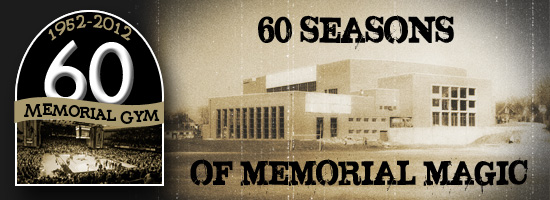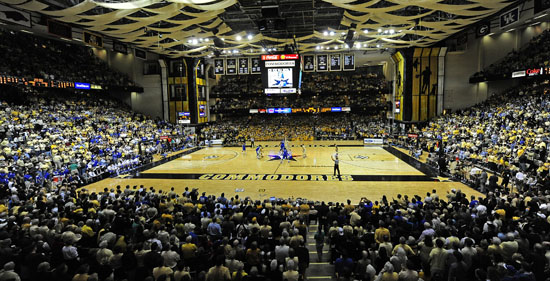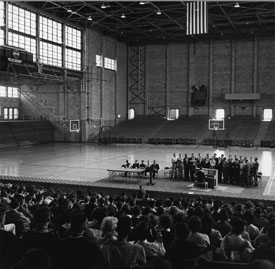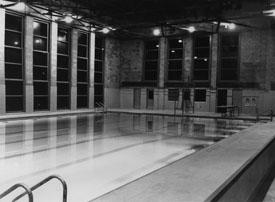Feb. 27, 2012

Memorable Moments: 1-12 | 13-24 | 25-36 | 37-48 | 49-60 | Other Moments | Fan Favorites
 Memorial Magic Video |
Memorial Magic Video | ![]() Memorial Gym Over Time
Memorial Gym Over Time
This is the 60th season of basketball in Memorial Gymnasium. To commemorate the occasion, VUCommodores.com will commit the next five days to recall 60 of the most memorable moments from men’s and women’s basketball games played on Vanderbilt’s home court. Each day, VUCommodores.com will reveal 12 historical moments, totaling 60 by Friday. The moments will not be listed by rank.
When architect Edwin Keeble put the finishing touches on the renderings of Memorial Gymnasium, little did he know at the time that 60 years later the gym would host the plethora of historic moments that it has and be the site of so many deep-seated memories for Vanderbilt fans.
Every Vanderbilt fan has a memory from Memorial Gym. The building is a famous symbol of Vanderbilt University and every quirk that differentiates Memorial Gym from other arenas only adds to its unmatched uniqueness. The building is filled with character and oozes with tradition.
| SUBMIT YOUR MOMENTS |
“Why are the benches on the baseline? Why is the court elevated? Why is the court so large?” Every Commodore fan has heard those questions before from people who see the gym for the first time. To an outsider, the gym defies every visual in their head for what a basketball gym looks like, and that is part of the beauty of Memorial Gym. Many have tried to describe the gym verbally, in writing or through television cameras, but after all these years there is still no way any description can fully do it justice.
There are older buildings with more history, but it would be hard to find another that has as many unique features as Memorial Gym. It is the building’s features that Vanderbilt players, coaches and fans love, but it is also its features that the opposition can’t stand. The typical topic that will have coaches bellyaching is the placement of the benches on the baseline. The feature cannot be found elsewhere in Division I, and is often the signature intricacy people know about Memorial Gym. The configuration of the benches can drive the opposition crazy at the time, but over the years it grows on people and only adds to the overall charm of playing in the building.
“I didn’t like the benches at the end because we spent too much time in front of our coach,” said ESPN analyst Jay Bilas, who went 1-1 in his two games at Memorial Gym as a player at Duke team. “You wind up on one end and you can’t hear anything and on the other end you can hear everything; it was just different. It was a great experience playing here. I loved it. C.M. Newton was a great coach and their teams were really good, so it was a real good challenge.”
Built in 1952, the gym was constructed with the foresight for future expansions. When it first opened, it looked like a giant barn. Over the years balconies were added on the north and south sides of the gym and walls were knocked down on the east and west sides to construct seating along each baseline. Unlike most venues that are circular in size, Memorial Gym is a rectangle with four distinct sides.

It’s been 60 seasons since the old gym first opened its doors for a basketball game against Virginia in 1952. Since that time, the building has provided so many indescribable and unthinkable moments that after a while, what went on inside Memorial Gym simply became known as Memorial Magic.
There have been buzzer-beaters, No. 1 teams defeated, and so many unthinkable moments that even the most pessimistic of spectators have had no choice but to believe in Memorial Magic.
“It seems like when we played there there was always a sense of drama in Memorial Gym, and it felt like we were playing up on a stage and that our opponents felt out of place,” said Wendy Scholtens (1988-91), one of four former Commodores to have their jersey retired and hung in the rafters. “I felt like that always gave us an extra boost in confidence and it was a very comforting feeling whenever we played there.
“It is such a unique place and it was just a great place to play and I vividly remember playing there and witnessing games there. I felt like there was a magic to the gym, there is no doubt about that.”
When it was built, Memorial Gym was dedicated to the Vanderbilt men and women who served in World War II, including the 144 individuals who lost their lives in combat. The gym originally seated, 6,583 and cost $1.5 million to construct. It was originally proposed as a combination fieldhouse and gymnasium with seats for 10,000 people, but that cost far exceeded the funds allotted for the project.
In its years of existence, Memorial Gym has hosted a wide range of events besides basketball games. There have been swimming competitions (yes, there was a swimming pool at Memorial Gym), a tennis match, a wrestling event, a boxing match and countless commencement ceremonies and concerts. But what the gym is most known for and what it does best is basketball.
 Over the building’s lifetime, Vanderbilt’s mens’ and women’s teams have won nearly 80 percent of its home games. The men’s team sports a 723-197 record and the women’s team is 413-93. Through the success at home, there has been a certain level of swagger that Memorial Gym has rubbed off on the players over the years.
Over the building’s lifetime, Vanderbilt’s mens’ and women’s teams have won nearly 80 percent of its home games. The men’s team sports a 723-197 record and the women’s team is 413-93. Through the success at home, there has been a certain level of swagger that Memorial Gym has rubbed off on the players over the years.
“We would go in against top ranked opponents and it wasn’t a confidence we were going to win or a thinking we were going to win, we knew we were going to win,” former Vanderbilt guard (1986-89) and current SEC basketball analyst Barry Booker said. “It was just a matter of by how much and what the details were going to be, but we knew what the outcome was going to be.”
But just what makes it such a decisive homecourt advantage?
There are many theories as to why the Commodores are so dominant at home. Is it the raised court? The benches on the baselines? The crowd noise that bounces back and forth off the walls? Or is it the odd shape of the building that makes the basket look like it is at a different depth from so many spots on the court?
“People always say that it is a great place to shoot a basketball and really it is not,” said Booker, the school’s top three-point marksman. “From the corner, things look a lot different then they do from the top of the key compared to the wing. It takes a while to get used to shooting the ball there.”
So maybe the key after all these years has been the ever-changing depth of the backdrop for which players must shoot against. Or maybe that is only part of the story.
“That is a big part of it, but there are so many things that the opposition has to adjust to that the home team is used to,” Booker continued. “The benches on the end lines, the scorer’s table. All those are unique elements that the opposing club has to adjust to.”
OK, maybe there really is no easily explainable reason for Vanderbilt’s success at home. There are a lot of little reasons that could be contributors, but in the end they all add up to one thing – Memorial Magic.
 Not everything is as it was in 1952. There have been additions and renovations, but through it all the character remains. The character not only remains, it shouts at you when you enter the building.
Not everything is as it was in 1952. There have been additions and renovations, but through it all the character remains. The character not only remains, it shouts at you when you enter the building.
This is the 60th season in the history of Memorial Gym. It is hard to believe the grizzled place – the oldest in the SEC – is as old as it is. There have been three expansions to the gym and the seating capacity has changed on four occasions.
But no matter how often the structure of the gym has changed or areas of the building have been renovated, nothing can replace the history that has been made on the foundation for which the building sits.
“I don’t know if it was just the age of the gym or the look of the gym, I don’t know what it was, but there was this other feeling of nostalgia that the gym brings out with the long history of basketball on campus,” Scholtens said. “As a player you kind of feel like you are a part of that as well.”
There is a mystique and aura to Memorial Gym that has been providing Vanderbilt fans and their families memories from one generation to the next for the last 60 years, and there will undoubtedly be many more memories to come.
To commemorate 60 seasons of basketball at Memorial Gym, VUCommodores.com will commit the next five days to recalling 60 of the most memorable moments from men’s and women’s basketball games played on Vanderbilt’s home court.
Each day, VUCommodores.com will reveal 12 historical moments, totaling 60 by Friday. The moments listed will not be in any particular order or rank.
With 60 seasons of basketball, it is inevitable that a memorable moment will be left out, albeit unintentionally. If there are moments from basketball games played in the building or if you have personal experiences that you would like to share (i.e. your first game), please click here to submit your memories.
The following week, we will publish the additional memories and stories that are sent in, along with a number of other memories that we didn’t have enough room to fit in the initial list of 60.
We hope you enjoy the next week of reminiscing about the 60 seasons of basketball at Memorial Gym.
Memorial Gym Renovations
Memorial Gym has gone through a host of expansion and renovations in its 60 years of existence. Here is a year-by-year look at the major structural changes made inside Memorial Gym.
1965
At a cost of $631,000, Vanderbilt constructed the north side balconies during the offseason between the 1965 and 1966 seasons. The balconies were proposed by Chancellor Rob Roy Purdy after Vanderbilt had sold out its 12 home games for the first time in school history before the 1964-65 season.
1967
The south side balconies of the gym, dubbed “The Balconies That Clyde Lee Built” were completed for $700,000 in December of 1967. The addition increased the capacity to 11,000 and the new seats sold out almost immediately.
1969
As a result of the demand following the addition of the south side balconies, Chancellor Purdy went back to the board to ask for more seats. The additional seats – 4,500 of them – would be constructed on the east and west sides of the gym. In order to do this, the construction crew had to knock out the original walls that were along each baseline and build out. The project cost $2,100,000, which exceeded the entire cost of the original facility.
With the addition, Vanderbilt attached each basketball hoop to two distinct beams that still hold the goals in place today. This was a change from the original construction that had the goals swing down from the ceiling. After the addition of the seats on the baselines, the seating capacity increased to 15,581 for the 1969-70 season.
2002
In 2002, a $25 million renovation was completed with the addition of the practice gym, coaching offices, a donor room and a Hall of Champions.
2008
In time for the 2008-09 season, the men’s and women’s locker rooms were renovated and a team meeting/video room was added. A new training room was also constructed. Capacity is currently 14,316.
Special thank you to Ron Bargatze, Barry Booker, Pat Nolan, Wendy Scholtens Wood, Jerry Southwood and Bill Traughber for their contributions in helping to make this project a reality.

